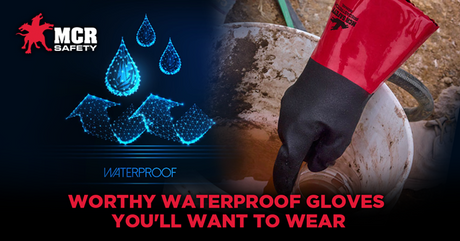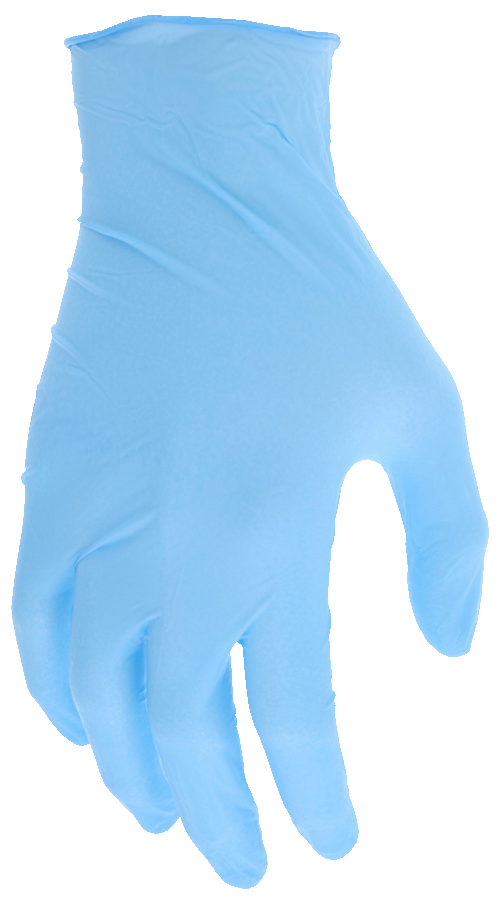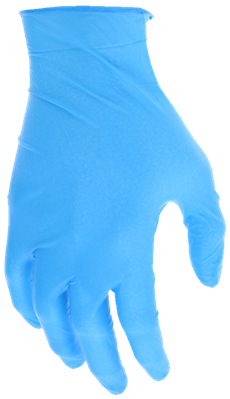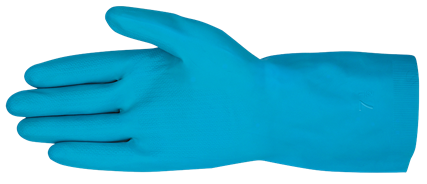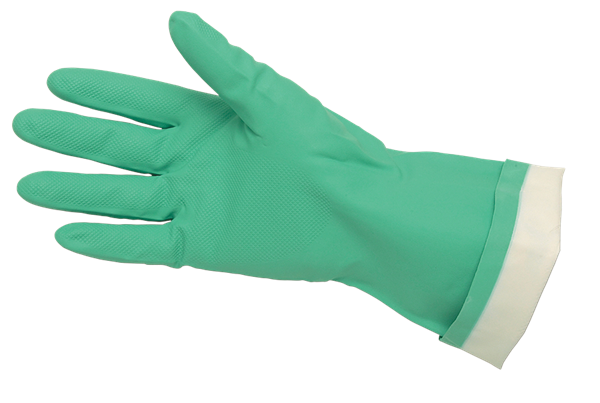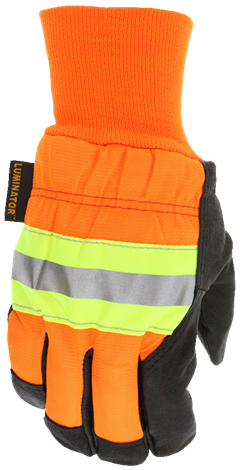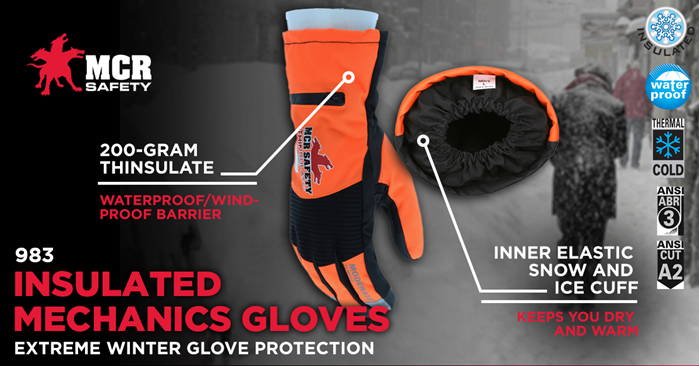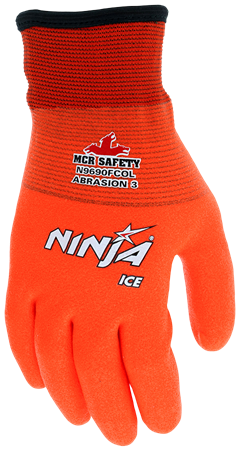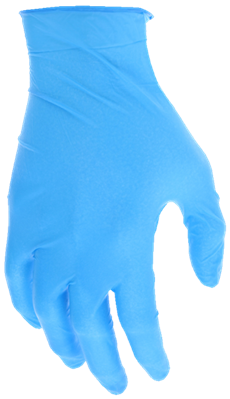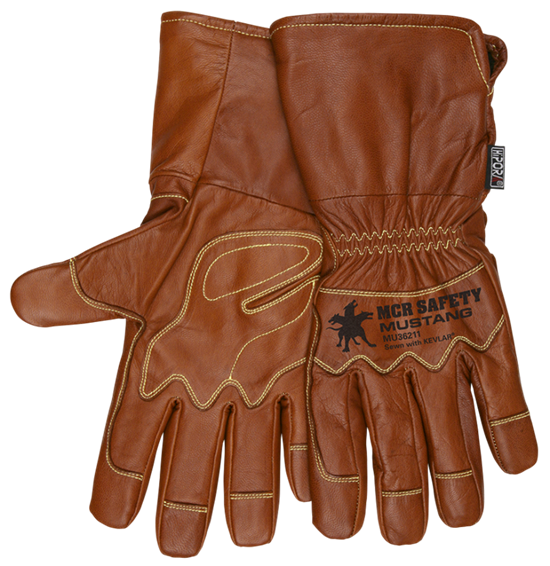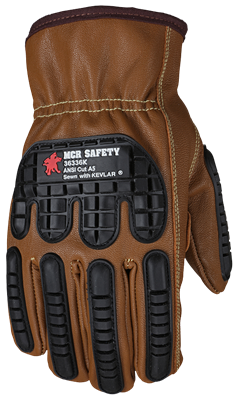Worthy Waterproof Gloves You'll Want to Wear
Posted by Anthony Webb on Nov 19th 2025
Waterproof work gloves are an absolute must for those who find themselves working in conditions that bring them in contact with water or other liquids. Whether that means working outdoors in inclement weather or working in or around water, a good pair of waterproof work gloves can be a literal lifesaver. Waterproof gloves can help you keep a tight grip on your tools while working and are an essential piece of equipment in cold or inclement weather.

MG9648, shown above in the top right, is our lightest-weight waterproof glove option.
Plumbers, commercial fishermen, and construction laborers can all testify that liquid protection is vital, as they encounter the need for it every day. And those who work in indoor freezers need waterproof options that also work to keep their hands warm. Waterproof gloves are not restricted to workers either. Outdoor activities such as cycling, hunting, sport fishing, all require waterproof gloves. Also, those those ride a motorycyle or own a boat know that having a waterproof glove around is helpful in the rain or wet conditions.
This article handles all the details you need to know about waterproof gloves, including what to look for when choosing waterproof work gloves; the differences between waterproof, water-repellent, and water-resistance gloves; waterproofing technology; and more.
Waterproof vs. Water-Repellent vs. Water-Resistant
![]()
We've seen these terms used to describe gloves and clothing, but what do they mean? It turns out they don't all mean the same thing.
- Water-resistant – as the name suggests, this means the material can resist penetration by water, but only to a limited degree. This term is often used to describe protective clothing. Most gloves that you put over your hand will initially resist water to some degree. However, once the glove is submerged in water, the glove will succumb to wet forces.
- Water-repellent – refers to material not easily breached by water, especially due to being treated with a protective coating. Water-repellent coatings repel water, making them hydrophobic and providing slightly more protection against water than water-resistant items. Due to the popularity of water-repellant styles, we're even now making styles that are oil-repellant too. However, like water-resistant gloves, both water-repellant and oil-repellent will be not hold up to water submersion. The water-repellent coating only adds an extra layer of defense over water-resistant gloves.
- Waterproof - means the glove is impermeable, and its protection cannot be easily breached by water. Almost any fully coated glove with a polymer, such as nitrile, PVC, or latex, will provide a waterproof barrier. However, as you'll read next, there are different technologies and feature found across all these options.
Waterproof Technologies

Waterproofing technology comes in four standard modes: treatment, waterproof barrier, disposable,
and lined solutions. Here is a look at each one.
Treatment

The most basic form of waterproofing involves treating the outside of a material with a water-repellent barrier. However, applying this type of treatment yields relatively short-term results as the treatment tends to wear out and quickly becomes less effective as a waterproof barrier. The treatment approach to waterproofing is best used in environments where the waterproof feature is not the primary protective feature. Our Ninja® Ice gloves and some additional non-insulated styles use a Hydropellant Technology (HPT) treatment to repel water. It's an outstanding feature that complements the cold protection users seek, especially when it's snowing outside.

Waterproof Bladder
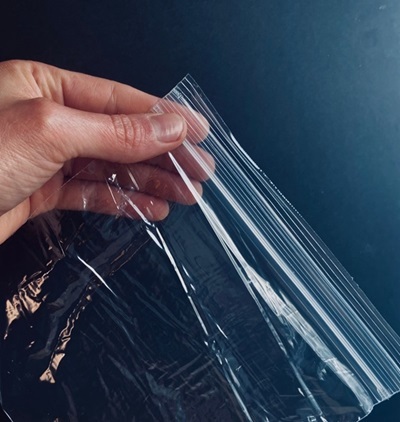
Many of our gloves offer a waterproof bladder to help guard against water. These hipora-lined options feature a breathable 3-layer microporous membrane that prevents water from entering. The inserted liner is like a lightweight, highly flexible sandwich bag protecting your hands from water and liquids.
Disposable Gloves
High-dexterity waterproof gloves are essential for those who need an excellent sense of touch. By their nature, disposable gloves are super-thin, essentially skin-tight gloves that provide the most dexterity and tactile sensitivity of all forms of waterproof gloves. Since they are inexpensive, once soiled, disposable gloves are meant to be thrown out. With no liner beneath the polymer, these gloves are not intended to last very long, and the waterproof feature can quickly become useless if the glove is ripped.

If you need an increased sense of touch but want a longer-lasting disposable glove, a glove style made with a higher millimeter thickness, allowing for more extended wear without sacrificing dexterity or sense of touch. 6 mil and 8 mil are designed to last longer than your traditional 4 mil style, often worn across industries. We cover both latex and unlined nitrile gloves below.
Lined Solutions

Lined Single-Dip

Single-dipped gloves have one polymer coating applied to the top of an inner shell that helps keep your hands dry. The shell is often a cotton knit fabric called an interlock lining that helps keep gloves lightweight and flexible.
Lined Double-Dip

Double-dipped waterproof gloves offer the user increased waterproof protection. Most of our double-coated gloves are also rated as chemical-resistant gloves. So, if the glove can resist harsh chemicals, double-dipped gloves can most definitely stand up to most liquids.
Lined Triple-Dip and Multi-Dip

Triple-dipped gloves are the most effective waterproof solution we have to offer. Our 6632 features three dips of premium PVC, ensuring the water stays off your hands. You will also find some of our neoprene glove styles reference multi-dip, which means at least three dips are applied to the glove.
Thin Styles

The thinnest waterproof glove in our product lineup is the MG9648. Comfortable and easy to wear, the PredaStretch™ MG9648 features a PVC/nitrile bi-polymer double-dip, providing excellent dexterity and grip for even the slickest of fish. The 12-inch gauntlet cuff offers extended protection, too.

Also, as we highlight in our glove liners article, you can waterproof any thin glove by incorporating a disposable glove as an inner bladder or an exterior glove. We recommend placing a latex or nitrile disposable glove over a cotton glove, which will provide a waterproof layer of protection for the cotton glove while providing a comfortable cotton material against your hands. A disposable glove can turn any of the gloves shown below into a waterproof design.
A disposable glove, the perfect waterproof glove shell
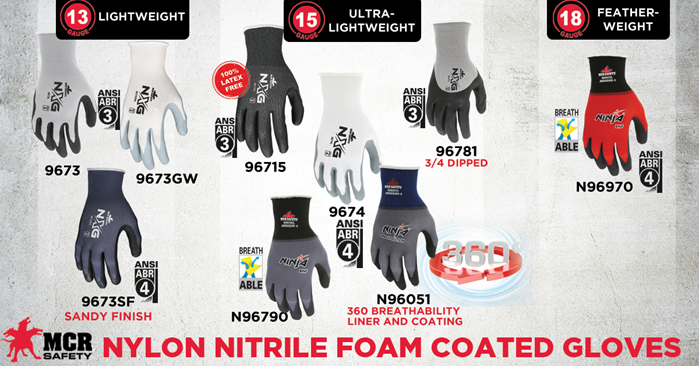
Waterproof Rubber
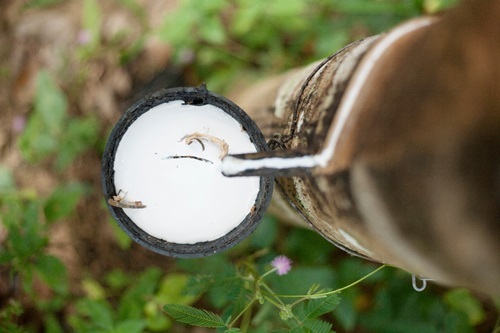
Humanity makes hoses out of rubber to keep water in check. Why not use rubber for gloves, too? The only difference is that we're using rubber to keep water from reaching your hands. Here are some of our best-selling rubber options:
Lined

Latex rubber gloves have an extra thick coating to ensure the water stays at bay. Plus, both options shown below have a crinkle latex design, helping you grip wet objects.
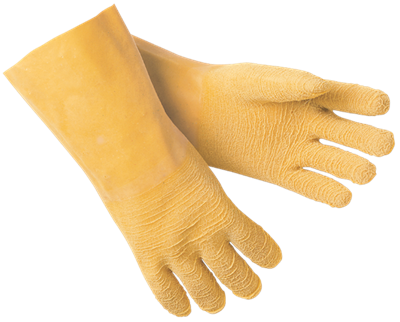
Unlined and Flock-Lined Latex
Sleek-fitting, unlined latex gloves do an excellent job of keeping liquids off your hands. It's why
you'll find almost anyone who is washing dishes wearing this type of waterproof glove.

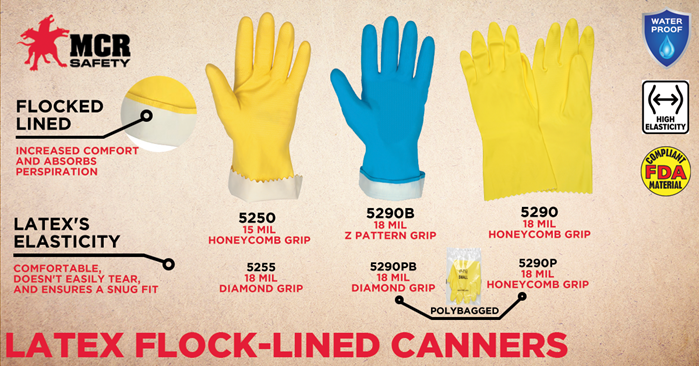
Nitrile Options
When you are working around oils or prefer a glove with a little more ruggedness, nitrile waterproof gloves are your go-to option. The two images below showcase our lined and unlined nitrile waterproof gloves.


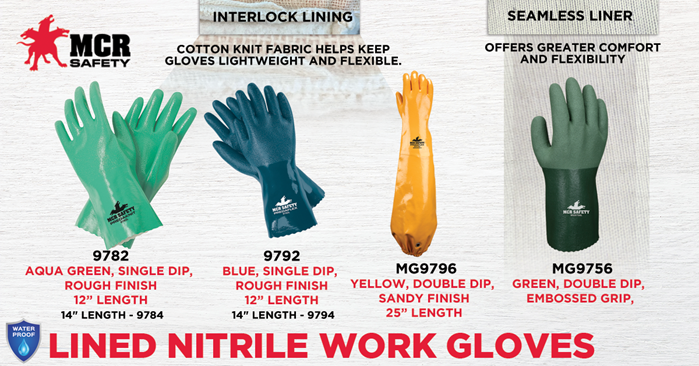
PVC Options
One of the top-selling PVC gloves in our lineup is the 6410SC. And, if you doubt that, check out the number of top reviews it receives on Amazon. Its popularity comes as a result of its double-dipped
construction featuring a soft jersey lining for comfort. It also has a safety cuff for easier donning and doffing. Here are some other PVC gloves to consider.

Core Features
![]()
If you work outdoors in the winter, in the rain, around water, or in the wind, MCR Safety makes several styles of waterproof winter work gloves that work to keep cold, wet moisture away from hands, ensuring greater heat retention.
An ideal pair of gloves is designed to keep you safe for almost all working environments and applications. Here are some examples of waterproof gloves made with specific features to keep you safe from the elements.
Cut-Resistant Gloves
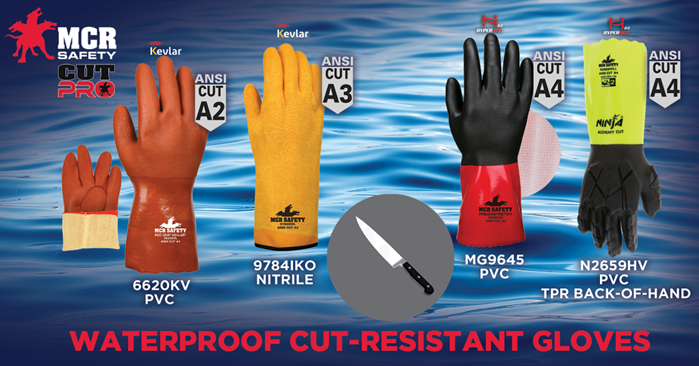
The MG9645 is a waterproof, cut-resistant glove made of unique materials to reduce the risk of cutting your skin on sharp objects. It is super lightweight and lined with a cut-resistant shell, providing A4 cut resistance and ANSI Level 1 heat protection.
For those who need additional heat protection, check out the 6620KV, shown above. It's lined with DuPont® Kevlar™, ensuring your hands are protected from water, chemicals, heat, and cut hazards. When you work around chemicals and cut hazards, the last thing you want to worry about is the sharp hazard cutting through the polymer and allowing the chemicals to enter. That's why we put the cut-resistant shell on the outside of the 9784IKO glove shown above!
Traffic Control
34411 features a reflective back, ensuring you're seen in low-light environments or
busy intersections. It comes equipped with a waterproof bladder, too!
Out Best Winter Glove
MCR Safety's best waterproof winter glove for keeping water out and the heat in is the 6714FF, a double-dipped, PVC-coated, insulated work glove lined with polar fleece and foam. The 14-inch length and an inner knit wrist provide increased protection. The sandy textured finish and high-visibility orange PVC coating help keep your hands safe and seen.
Waterproof Windproof
![]()
To ensure they purchase high-quality, warm, comfortable PPE, laborers from almost all industries turn to MCR Safety work gloves with Thinsulate™ insulated liners. Thinsulate™-lined gloves are a must when working outdoors in cold temperatures as they protect against frostbite, numbness, and sensitivity to cold. We stock waterproof options in this glove, too.
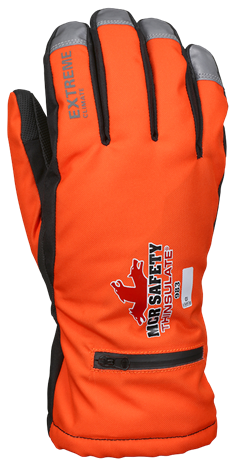
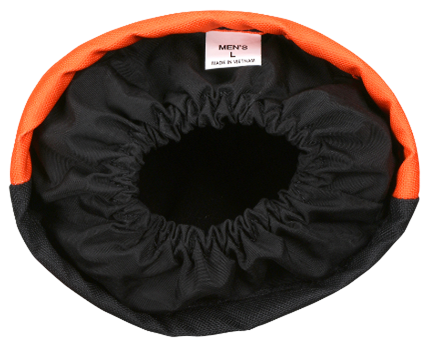
For the coldest of jobs, you won't find warmer gloves than MCR Safety's 983 Extreme Climate style. This glove has the thickest Thinsulate™ lining we offer and is designed to stand up to extreme temperatures without interfering with your job. Our 983 Extreme Climate cold weather glove is equipped with a heavyweight 200g Thinsulate™ liner and is designed with room for a HotHands® hand warmer pack to be inserted on the back of the hand.
Additional Waterproof Warm Options
MCR Safety's 926 gloves are equipped with a 40-gram Thermosock® lining and a waterproof/windproof bladder, plus a synthetic leather palm with silicone dots. This glove will give you the grip, durability, and protection you need for jobs in wet and cold conditions. The 926 glove also features a black terry cloth thumb, black neoprene knuckle strap, and hook and loop wrist closure. Other features include a hi-vis green fabric back.
Thin, Lightweight, and Water-Repellant
Gloves that are warm, thin, and waterproof are hard to come by. MCR Safety's Ninja® Ice winter gloves have been one of our best-selling winter work gloves for over a decade and with good reason. The HPT coating on the palm of these gloves creates encapsulated air molecules that repel liquids for an unprecedented firm wet or dry grip. This kind of water resistance keeps you warm and dry even in extreme conditions so that you can do your job safely and comfortably.
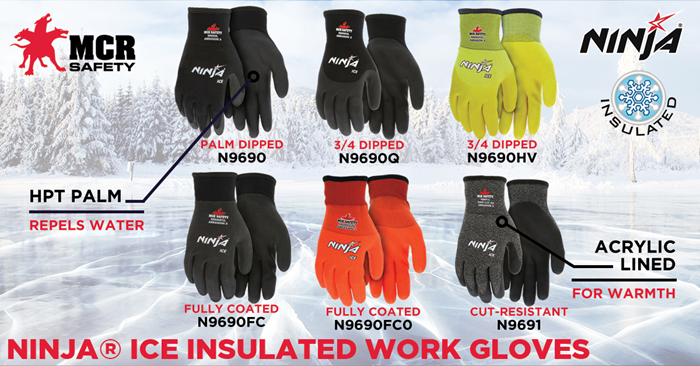
We recommend wearing our water-repellant Ninja® Ice gloves combined with a disposable glove liner underneath to make them waterproof. By combining these options, you'll have a water-repellant coating, a thermal liner, and a waterproof interior, all with a thin work glove.
Leather Glove
For those who prefer using leather gloves, even when it's wet outside, you'll want to check out our MU36211 shown above. We also mentioned an oil-repellent technology earlier on in this article. The 36336K is coated with this oil-repellent technology, shown below.
Common Questions

How to dry the inside of waterproof gloves?
- The best way to dry gloves is to hang them up, allowing them to dry independently naturally. It is best to find a warm, dry location to hang them up and avoid putting them in the dryer or ringing them out, especially leather work gloves, as they are delicate. You can wrap the gloves with a towel to remove some water before hanging if they are exceptionally wet.
What is a good winter waterproof work glove?
- "Good" is a subjective component of any product purchased. If you only require a water-repellent design, then the Ninja® Ice is one of the best options we offer. For those who want a warmer waterproof design, we recommend the 926, 980, 981, or 983.
What are the warmest waterproof gloves?
- The 6714FF is the warmest winterproof waterproof glove we offer due to its foam and polar fleece lining equipped underneath a double-dip PVC outer coating.
How to waterproof deerskin gloves?
- Deerskin gloves are the most luxurious leather found in leather gloves, which means users like to keep them on in all conditions. Nixwax makes several waterproofing products designed for leather, which you might want to consider trying out if you plan to wear your leather gloves in all conditions. If you would prefer having more of a waterproof design over deerskin, check out our MU36211.
Keeping Your Hands Dry
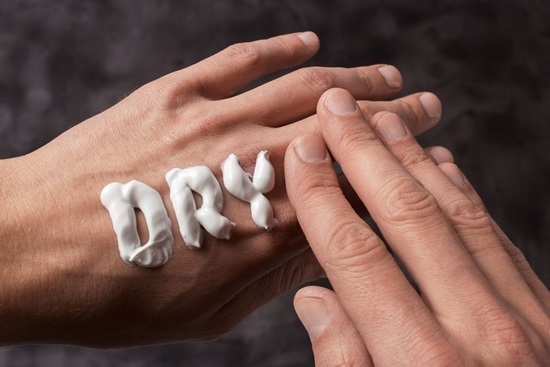
We hope the above has cleared up any confusion you may have had around the subject and that you've spotted a style or concept worth exploring further. If you're working in wet and cold conditions like outdoor construction, fishing, or landscaping, a quality pair of waterproof gloves can protect your hands from the elements, keeping them dry and warm and ready to tackle any job. If you have questions about our waterproof work gloves, don't hesitate to reach out to us.
We welcome any comments, feedback, or suggestions for how we can best protect people at work.
For over 45 years, MCR Safety has proven to be a world leader in gloves, glasses, and garments. Whether it's on the shop floor, an oil rig, a construction site, or shooting outdoors, we are there to provide solutions to workplace (and recreational) hazards. It's all part of our commitment to protect people.
No matter your industry, we have the personal protective equipment you need.
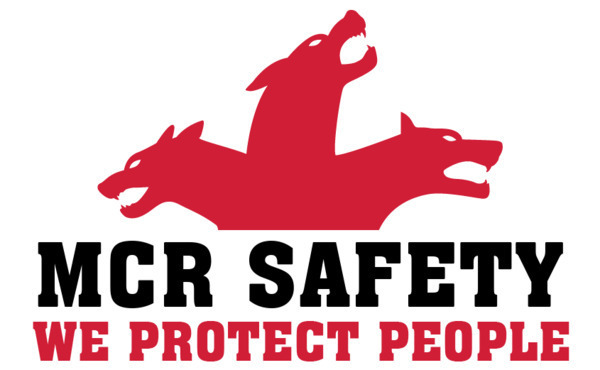
Learn more about MCR Safety by checking out our most recent video. For more information, browse our website, find a distributor, or give us a call at 800-955-6887.

